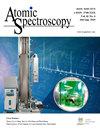Rapid Two-Column Separation Method For Determining Barium Isotopic Compositions Using MC-ICP-MS
IF 2.3
2区 化学
Q1 SPECTROSCOPY
引用次数: 0
Abstract
: In recent years, the stable isotope composition of barium has emerged as a powerful tracer for understanding crucial geo-social processes; therefore, it is necessary to develop an efficient method for Ba isotopic ratios. Herein, we describe a rapid method for determining the isotopic ratios of Ba using a multi-collector inductively coupled plasma mass spectrometer in the low-resolution mode (Neptune Plus). In this method, the exact amount of the resin and the low eluted volume of the acid used in column purification significantly reduce the time required for Ba separation. Instrumental mass bias calibrations were performed for both standard-sample bracketing (SSB) and double-spike methods. The results show that the double-spike method provided Ba isotopic ratios with higher precision than the SSB technique. The effects of acid molarity and concentration mismatch, as well as the potential matrix effect, were investigated in the wet plasma mode. We evaluated the Ba isotopic compositions of ten geological reference materials, namely, BCR-2, BHVO-2, AGV-2, GSP-2, RGM-2, G-2, GSR-3, GSR-5, GSR-8, and GSR-11. Results indicated that these compositions were highly accurate with respect to the international Ba isotope standard, NIST SRM 3104a. Furthermore, the Ba isotopic compositions of most geological reference materials examined in this study agreed well with previously published data within the quoted analytical uncertainties. The long-term reproducibility analyses of all standards indicated that the obtained isotopic ratios were highly reproducible for δ 138/134 Ba, with precisions of ≤ ±0.05‰ (2SD). Compared to previous reports, we optimized the process of chemical purification, separated Ba samples faster, and improved the efficiency of the analyses employed in this study.MC-ICP-MS快速两柱分离法测定钡同位素组成
近年来,钡的稳定同位素组成已成为了解关键地质社会过程的有力示踪剂;因此,有必要开发一种有效的Ba同位素比值测定方法。在此,我们描述了一种在低分辨率模式下使用多收集器电感耦合等离子体质谱计(Neptune Plus)快速测定Ba同位素比率的方法。在这种方法中,精确的树脂量和在柱纯化中使用的低洗脱量的酸显着减少了Ba分离所需的时间。仪器质量偏差校准进行了标准样品包围法(SSB)和双尖峰法。结果表明,双尖峰法比SSB法提供的Ba同位素比值精度更高。在湿等离子体模式下,研究了酸的量浓度和浓度错配以及电位基质效应的影响。对BCR-2、BHVO-2、AGV-2、GSP-2、RGM-2、G-2、GSR-3、GSR-5、GSR-8、GSR-11等10种地质标准物质的Ba同位素组成进行了评价。结果表明,这些成分相对于国际Ba同位素标准NIST SRM 3104a具有很高的准确度。此外,本研究中检测的大多数地质参考物质的Ba同位素组成在引用的分析不确定度范围内与先前发表的数据一致。所有标准品的长期重复性分析表明,所获得的同位素比值对δ 138/134 Ba具有良好的重复性,精密度≤±0.05‰(2SD)。与以往的报道相比,我们优化了化学纯化的过程,更快地分离了Ba样品,提高了本研究的分析效率。
本文章由计算机程序翻译,如有差异,请以英文原文为准。
求助全文
约1分钟内获得全文
求助全文
来源期刊

Atomic Spectroscopy
物理-光谱学
CiteScore
5.30
自引率
14.70%
发文量
42
审稿时长
4.5 months
期刊介绍:
The ATOMIC SPECTROSCOPY is a peer-reviewed international journal started in 1962 by Dr. Walter Slavin and now is published by Atomic Spectroscopy Press Limited (ASPL). It is intended for the rapid publication of both original articles and review articles in the fields of AAS, AFS, ICP-OES, ICP-MS, GD-MS, TIMS, SIMS, AMS, LIBS, XRF and related techniques. Manuscripts dealing with (i) instrumentation & fundamentals, (ii) methodology development & applications, and (iii) standard reference materials (SRMs) development can be submitted for publication.
 求助内容:
求助内容: 应助结果提醒方式:
应助结果提醒方式:


